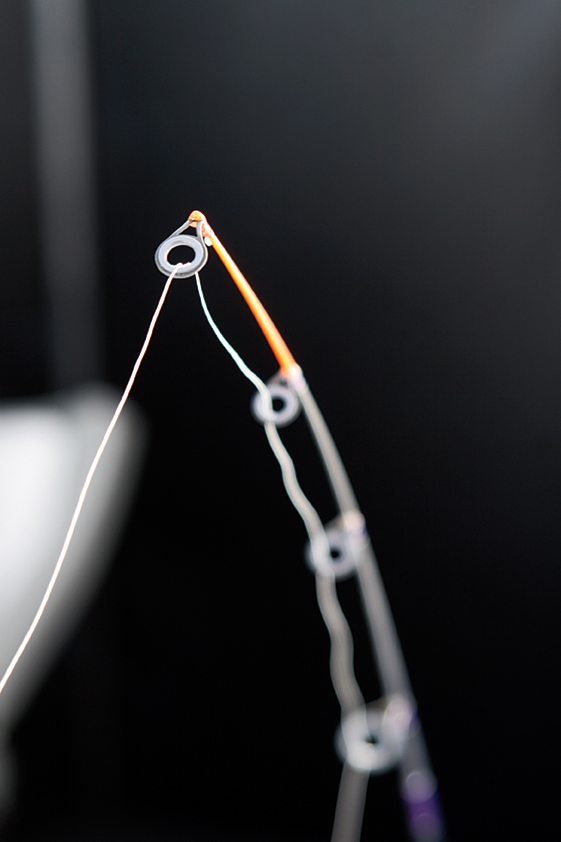
 One guy is jigging with two rods. Another angler has one rod lying across a bucket. And he’s catching all the perch. “What the heck are you doing?” asks the first guy. “Nothing,” says the other.
One guy is jigging with two rods. Another angler has one rod lying across a bucket. And he’s catching all the perch. “What the heck are you doing?” asks the first guy. “Nothing,” says the other.
That’s the punch line. The joke, compliments of walleye pro and intuitive ice angler, Mark Martin, is funny because it’s true. He tutors ice fishermen on various bodies of water all winter (Mark Martin’s Ice Fishing Vacation Schools), where he and his staff have refined deadstick perchfection over the past decade.
“Over time, my pro staff has discovered that using a deadstick and merely tapping it once in a while at least doubles your catch,” Martin says. “Where three rods are legal, we use one jigging rod and two deadsticks with jigs tipped with waxworms or plastic. I don’t know why, but if you tap a deadstick rod once in a while, it catches far more perch than jigging.”
On small lakes? Great Lakes? Everywhere? “Gogebic, Saginaw Bay, Muskegon Lake, Erie — doesn’t matter,” he says. “We’re convinced — deadsticks outfish jigs everywhere we go. No doubt, Great Lakes perch are different than the ones we find in drowned river-mouth lakes and inland lakes. Lake Michigan anglers often refer to Great Lakes perch as white bellies and inland perch as yellow bellies. The cry goes out, ‘the white bellies are in’ and people first begin intercepting them 60 feet down in late fall with jigging spoons or spreaders rigged with a couple Aberdeen hooks tipped with minnows. They start in boats then walk out on thin ice past the pier heads, contacting perch that are moving into these connected lakes.”
In the past, perch were following shad. “Shad are less common now,” Martin says. “Perch feed on whatever shad they can find and transition quickly to bugs. We use ice flies or spoons with single hooks tipped with maggots, mayfly nymphs, waxworms or Berkley Gulp! most of the winter. Single-hook spoons wobble a little more. Lake Michigan isn’t exactly sterile, but these drowned river-mouth lakes have much more invertebrate forage.”
Find spottail shiners or troutperch and it’s game on for white bellies. “If you’re catching them along with yellow-belly perch, you’ve got the area wired. That’s my key on big water. Houghton Lake, Gogebic — on any lake not connected to the Great Lakes, we find perch by following transitions at the edge of mudflats where invertebrates are thickest. The typical depths are 19 to 36 feet. Shallower mudflats in 8 to 12 feet are used primarily when the vegetation is still green. If plants are dead, perch move to deeper flats. A camera tells the story quickest. If the weeds are green, you’ve found yourself a little restaurant. Brown vegetation? Move to those deeper flats, but everywhere perch hit a small teardrop tipped with waxworms or wigglers.”
In drowned river-mouth lakes, white bellies follow the same program if they stick around. “Finding yellow bellies in deep water?” Martin asks rhetorically. “They’re leaving home. If you catch yellow bellies in deep water, it indicates the weeds are dying. Lake Michigan perch — the white bellies — never occupy shallow water. They coexist in the drowned rivermouth lakes when the weeds are dying. Otherwise, you have a stark distinction — yellow bellies are shallow and white bellies are deep. In super-clear lakes, vegetation dies off fast. Yellow bellies wander the shorelines more, but deeper — down 25 to 30 feet. If the transition from hard to soft bottom is at 30 feet and it extends out into the middle of the lake, perch are there. All these forage-related factors have everything to do with deadsticking.”
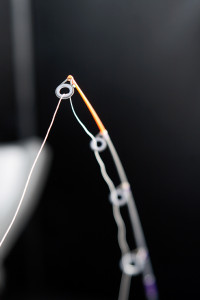 Deadstick Details
Deadstick Details
“If you have bait on the jig and tap your deadstick rod every few minutes, perch come in,” Martin says. “It’s weird. The best program is a single-hook spoon with bait. Current makes it wobble when the angler leaves it alone, and when it wobbles it moves the bait. Take a #3 Jigging Rapala with no bait — put a light-wire #8 Aberdeen on it and it catches current and moves more. Last year on the dead rod, using a #3 Rapala with no bait, I caught a few walleyes and countless perch.”
Martin jigs with a Rapala, the smallest Northland Buck-Shot Rattle Spoon, or a VMC Tingler. “We use the single hook that comes packaged with a Swedish Pimple,” he says. “That hook is heavier and holds heavier fish. But the deadsticks catch more perch.”
Perhaps anglers that find the opposite true are not hanging baits high enough. Martin’s crew suspends baits way off bottom — far enough to make other anglers scratch their heads. “People fail to believe their fishfinders,” he says. “White bellies suspend up to 15 feet off bottom in 40 to 50 feet of water on spottail shiners and troutperch. Lots of perch suspend in these systems and most people fail to take advantage of it. You want perch to see it from a distance.
“If the bait is 15 feet off bottom, that’s where we set the deadsticks. About 4 to 5 feet up is the norm. If perch are on bottom, they swim up for it. Even when they’re on bottom, rooting around for insects, they come up 4 feet or more for deadstick presentations. In shallower areas, we keep it 2 feet off bottom. Some of my pro staffers rarely jig. They merely tap the deadsticks every few minutes. I can’t do that. I have to jig with at least one rod, but I never jig with two rods anymore.”
Deadsticks used by Martin’s staffers are deployed in rod holders from various companies. “The ones that clip onto buckets or tents are most popular,” he says. “I like the coated wire ones, such as Today’s Tackle Rod Rocker 2. My staff either uses a split shot and Aberdeen hook, a vertical jig like the Custom Jigs & Spins Rat Finkee, or a spoon with a single hook.
“Deadsticks beat jigging every day, everywhere we went for the past several years. We’ve taken it to a different level and figured out a new way to jig and it’s not to jig at all. Giving perch a decision between jigging and the deadstick is the idea, but we think there’s too much for perch to process when you’re jigging in cold water. We can’t hold it still enough long enough most days.”
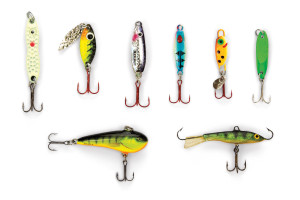 Minnow Matters
Minnow Matters
Walleye and crappie pro Tommy Skarlis agrees the cold has a lot to do with deadsticking success on ice. “The water is colder than it is all year,” he says. “Perch won’t move as fast or follow fast movements as they do in summer. Watch a minnow in cold water. It uses less body movement getting from point A to point B, and it’s generally motionless a much larger portion of the time. The jig should look like a minnow, which tries to stay inconspicuous. The deadstick has natural appeal because, first and foremost, perch are looking for something easy that won’t make them move more than they have to.”
Skarlis uses a “dead hole — active hole” system. “I drill two holes side-by-side,” he says. “One is a deadstick hole, with a spoon and a minnow or jig and minnow or just a hook, split-shot, and a minnow. I use clip-on rod holders or use the mesh pockets on the side of the shelter. You have to anchor them because a deadstick becomes a gone stick if you don’t. Today’s Tackle Rod Rocker 2 is my favorite.”
Outside the shelter, Skarlis is rarely more than 2 to 3 feet away from his deadstick, actively working a jigging rod. “I often use a bobber with the bail open on the deadstick,” he says. “I never mess with it unless I need to rebait.”
Sometimes Skarlis wants the presentation totally dead, sometimes struggling. “Let the perch decide whether they want an active deadstick minnow or a dead one. If you I draw them in but they won’t hit an active spoon or jig, I use a dead minnow. Sometimes I step on the minnow so the blood and guts are trailing off it.
“The active jigging rod tells the story. If perch want action, you put a lively minnow down. For the most lively look, hook it under the dorsal fin. There are stages to this. Where three lines are legal, you can set deadsticks on either side — one totally dead, the other with a live minnow hooked various ways to accentuate or deaden activity. I jig with a spoon in the middle, covering three bases.”
Like Martin, Skarlis never jigs with two rods for perch anymore. “Most days, wherever I go, I’m better off with at least one deadstick rod deployed at all times,” he says. “The trend toward moving and grooving and being aggressive is great. Mobility opens a lot of opportunities, helps you learn the water faster, and catches a lot of fish.
“But with perch, you often know if they’re around and it’s better to sit. Have patience. No better way to do that than with a deadstick because, otherwise, we tend to move too much. If I’ve made mistakes over the years, it’s probably when I went totally active for perch and moved too quickly and too often.”
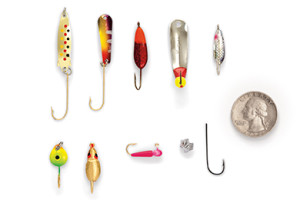 Skarlis actively jigs with lures and spoons that have trebles. “JB Lures Big Bad Bo or a Salmo Chubby Darter are my first options most days,” he says. “When you stall the Chubby, it sits there like a deadstick tool. I load it with a minnow head when perch spit up minnows and I load the treble with waxworms or maggots when they’re spitting up that brown paste that tells you they’re feeding on invertebrates.”
Skarlis actively jigs with lures and spoons that have trebles. “JB Lures Big Bad Bo or a Salmo Chubby Darter are my first options most days,” he says. “When you stall the Chubby, it sits there like a deadstick tool. I load it with a minnow head when perch spit up minnows and I load the treble with waxworms or maggots when they’re spitting up that brown paste that tells you they’re feeding on invertebrates.”
Rod designer and Guide Jason Mitchell, who created one of the finest deadstick rods for perch, agrees that forage options determine the approach. “When perch are chasing minnows, their bodies have a bigger, rounder shape with bigger heads,” Mitchell says. “When they feed heavily on bugs and scuds, as they do in the Dakotas, you get fish with big bodies but smaller heads and they’re much more likely to be caught on deadsticks.
“When people start talking about needing cameras to catch perch, you know it’s a deadstick bite. The need for deadsticks becomes obvious on smaller lakes, where the only real chance you have is to put a bait out and let it sit. Those fish make jigging anglers look bad. They don’t rise or chase, they don’t change posture when they come in, and they stare at baits a lot.”
Mitchell’s key to deadsticking success is a slow, deliberate hook-set. “I don’t believe in standard rod holders,” he says. “The rod has to have a light tip, of course, but with a heavy backbone. It’s like pulling spinners and crawlers in summer. That slow increase in tension results in more hookups. When perch feel a slow, steady, increase in tension, it makes them clamp down harder. Swinging up on them like a baseball bat makes them let go.”
For mobile anglers, deadsticking can seem inscrutable. “Deadsticks are like an anchor,” Mitchell admits. “You can’t move. You need a couple things going for you to be successful when deadsticking. You have to know where you need to be and you have to know it’s going to be one of those hair-pulling bites. Sometimes you dance a lure and perch never accelerate toward it. That’s a dead giveaway.”
On smaller lakes, Mitchell rarely sees the need to suspend deadstick baits up high. “On Gogebic, perch key on invertebrates,” he says. “They might switch to shiners more of the year, but in winter invertebrates comprise most of the forage for inland-lake perch. Weather is another factor. Deadsticks shine after severe cold fronts. But when you don’t have competition from other anglers, the opposite happens. If perch have been left alone, they’re more likely to chase and respond to a jigged spoon.”
Mitchell deadsticks with waxworms or minnows most of the time. “Wigglers (mayfly nymphs) work great where you can get them,” he says. “A lot of people use a plain hook and a split shot, but I take a small spoon, remove the treble, and replace it with a long-shank Aberdeen. With minnows, the hook goes in slightly ahead of the dorsal, along the side, and comes out toward the head. You want the barb to come out right behind the gill. A long-shank hook is important because it swings toward a biting perch. The minnow can’t go anywhere. You don’t want it shooting around or even able to swim. The lack of movement is key. Fish that respond to deadsticks respond best to a bait that’s not struggling, not swimming around, just sitting there.”
The day we long dreaded — the day of the living deadstick — has arrived. And it means more perch for all of us.
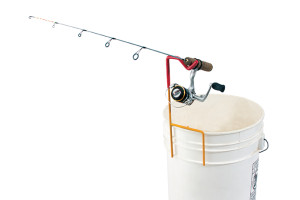 The “Perchfect” Living Deadstick
The “Perchfect” Living Deadstick
“When you run multiple lines, you get too much clutter on the sonar screen,” says Jason Mitchell, designer of the Meatstick Deadstick ice rod. “So I jig with little Northland Forage Minnows or Acme Kastmasters, which don’t generate a strong return signal. I can see what’s happening with the deadstick bait, which is right next to bottom most of the time. I like to set the rod on a bucket or balance it on a balance-beam-style rod holder so the tip is over the top of the hole about a foot. You’re sitting right there, it makes you more attentive, and you don’t want to give the fish negative cues by pulling the bait too hard to get it out of the holder.”








